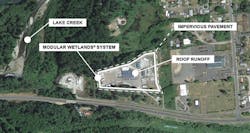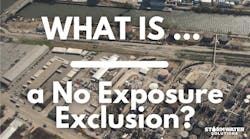Industrial Site’s Sustainable Storm Water Solution
Washington is a web of rivers, tributaries, wetlands and forests that support a seemingly endless array of wildlife species, as well as the economy and population. As in any growing state, commerce, industry and development are just as essential as the state’s natural resources.
Morton, Wash., is like many rural outcroppings that are tied to the economies of Seattle and Tacoma, Wash. This small town is nestled at the foothills of Mount Rainier and surrounded by mature woodlands and wetlands adjacent to Lake Creek (which feeds the Tilton River). A 10-acre new construction and industrial development on the outskirts of town is home to a medical-device recycling center, Stericycle. New industrial sites surrounded by Washington’s pure natural resources can be intriguing models of sustainable low impact development, given the proper proven solutions. They show how engineers and developers can successfully design storm water systems to achieve both short- and long-term economic goals and comply with the Washington State Department of Ecology (DOE) regulations and protections.
Situation
Stericycle’s new industrial recycling center is a 38,000-sq-ft property “serv(ing) thousands of customers throughout Washington,” providing waste disposal solutions and hosting an almost constant volume of trucking and delivery traffic from Olympia, Tacoma, Puyallup, Centralia and Vancouver, Wash.
Industrial-related trucking generates obvious pollutants of concern (POCs) that will continuously collect on the newly paved parking lot and large metal-roofed building.
Upon heavy rains and the “first flush” of storm water, these pollutants typically run off and enter the environment untreated. According to the Washington DOE, “Storm water can pick up pollution from factories and businesses. Those contaminants are carried into waterways and harm fish and other aquatic life. Storm water runoff is the leading threat to Washington’s urban waters, streambeds, banks, and habitats.”
“The engineer of record for this site needed to do the right thing for his client, the wetlands, and nature that surround the property, but big bioswales and non-proprietary [best management practices (BMPs)] are costly and often ineffective,” said Jeff Pierce, a local storm water expert for Bio Clean Environmental.
Challenge
Keeping construction and development costs down is always a top concern, but there was an added challenge of introducing enhanced storm water treatment to comply with the Washington State Department of Ecology’s regulations to “reduce storm water pollution leaving their site.”
This impervious land mass will generate storm water runoff filled with POCs—dissolved metals, total suspended solids (TSS), hydrocarbons and nitrogen—producing high treatment flow rates.
As stated by Washington’s DOE, “Emerging storm water treatment technologies (TAPE) are reviewed and certified by the Washington State Technology Assessment Protocol – Ecology. Better known as the TAPE program.”
Bio Clean’s Modular Wetlands System Linear is approved by the Washington State DOE for General Use Level Designation (GULD) for Basic (TSS), Enhanced (Heavy Metals – Zinc and Copper) and Total Phosphorous treatment regiments. This designation allows the system to be specified as a stand-alone BMP to mitigate these pollutants.
“This biofiltration system is the most reliable storm water device under these conditions, and the Modular Wetlands System is economical, reliable and approved by Washington State DOE,” Pierce said. “High treatment flow rates, in many systems, equate to high maintenance costs, but the Modular Wetlands is the only biofilter utilizing horizontal flow, allowing for multiple stages of treatment, compartmentalizing trapped pollutants. Our client will enjoy the lower excavation and construction costs, but also long-term low maintenance benefits.”
Solution
Designed for easy maintenance access, the first stage of the system is the pretreatment stage. Here, pollutants that cause clogging (if they migrate to the biofiltration chamber) are almost completely collected in convenient media filter cartridges, thus inoculating the main biofiltration chamber from heavy loads and making regular maintenance evaluations and cartridge cleaning quick and easy.
Horizontal flow also allows for internal high-flow bypass in a side-by-side orientation design, placing the pretreatment and discharge chambers adjacent to one another. During certain rain events, heavy downpour and water volumes can increase above the norm, causing some other systems—namely, typical downward flow systems—to fail as they get overwhelmed, releasing concentrations of collected pollutants into downstream woodlands, lakes and rivers. However, the Modular Wetlands System has the ability to allow those flows to bypass the main biofiltration chamber internally, an essential and highly valuable feature in heavy-rain states like Washington. For this site and the city of Morton, pollutants already successfully collected by the storm water biofiltration system will remain trapped and secure.
Attempting to mitigate these challenges with typical bioswales can be costly. Basic non-proprietary bioretention systems typically need 1,795 sq ft per impervious acre (in this case, 17,950 sq ft of space), but the Modular Wetlands System takes up a mere 189 sq ft (MWS-L 8-20 curb inlet application) at a depth of 6.5 ft, designed to treat 0.4794 cu ft per second of storm water.
According to Washington State’s DOE, “Wetlands are nature’s water filters, sponges and nurseries… wetlands cover approximately 938,000 acres in Washington, about 2% of the state’s total land area. Since the 1780s, Washington has lost 31% of its wetland areas, from 1.35 million acres to 938,000 acres. Wetlands are critical to the overall health of watersheds.”
[Visit Bio Clean's SWS Storefront]
Upon design, Bio Clean’s mission was to combine nature with technology in a versatile and advanced storm water biofiltration system. The system continues to prove itself and has been widely used in Washington, with hundreds of installations. No other storm water innovation has embraced the spirit of natural water filtration quite like the Modular Wetlands System, sustainably consolidating and reproducing the power of wild wetlands for the state of Washington and the world.


